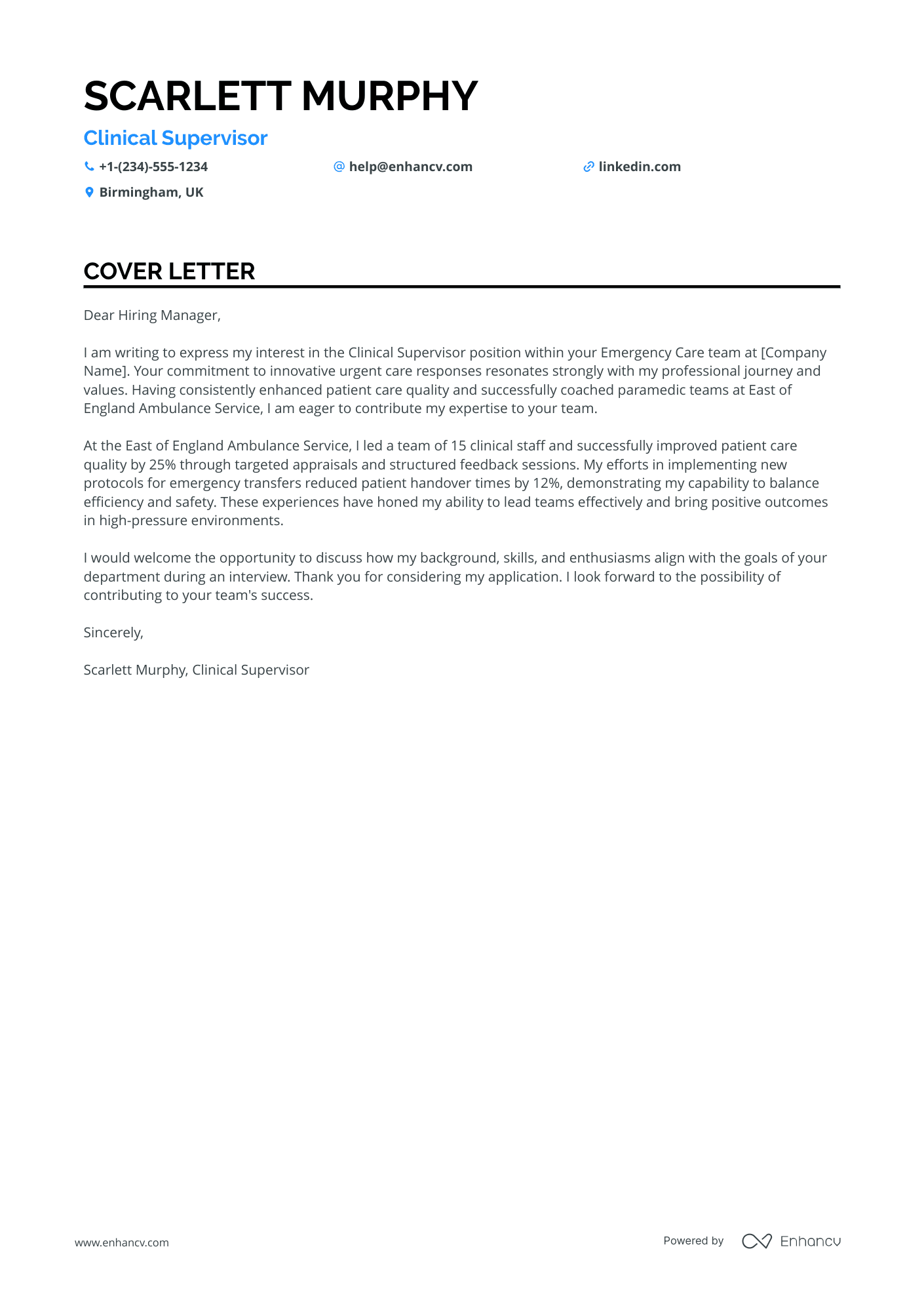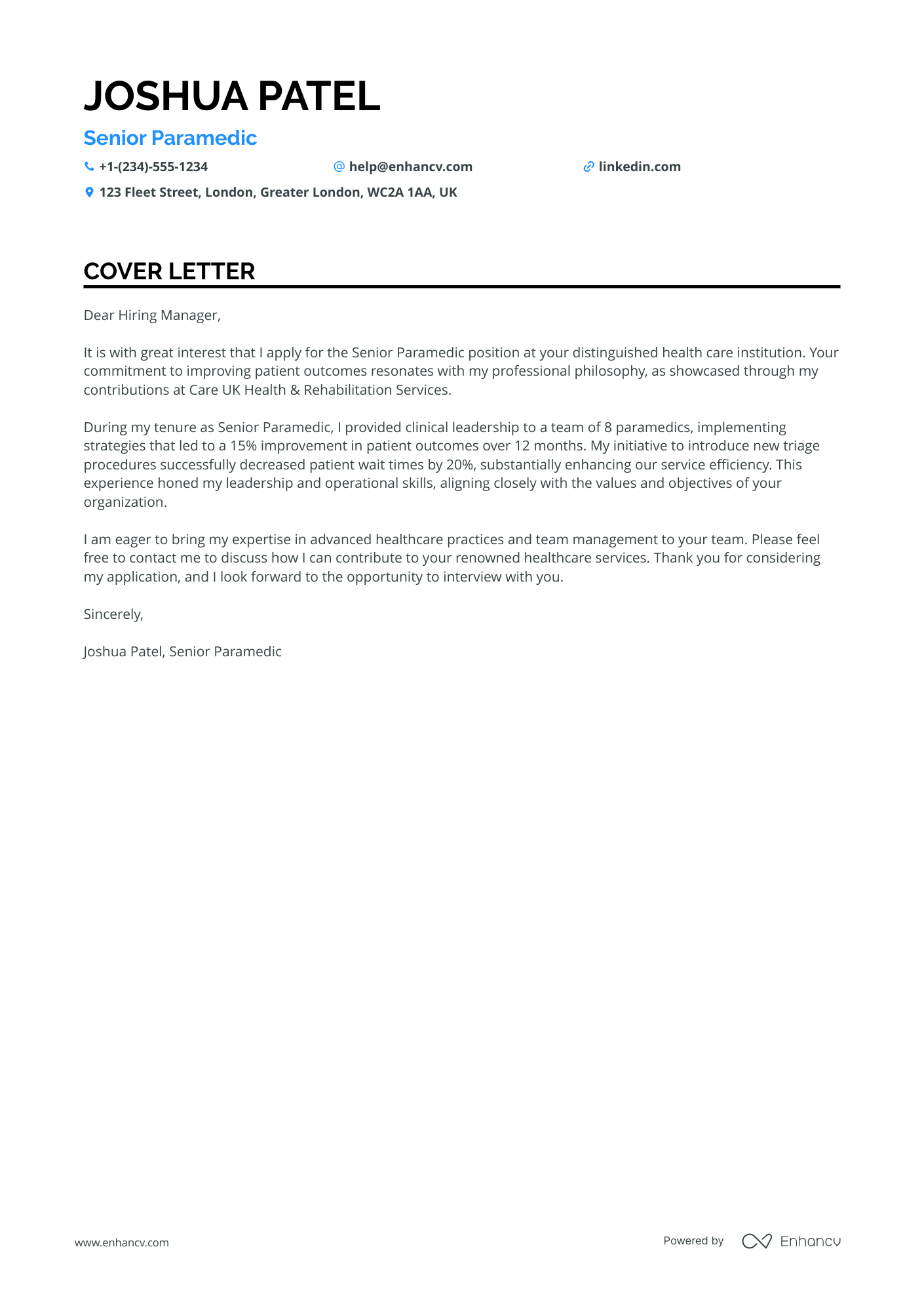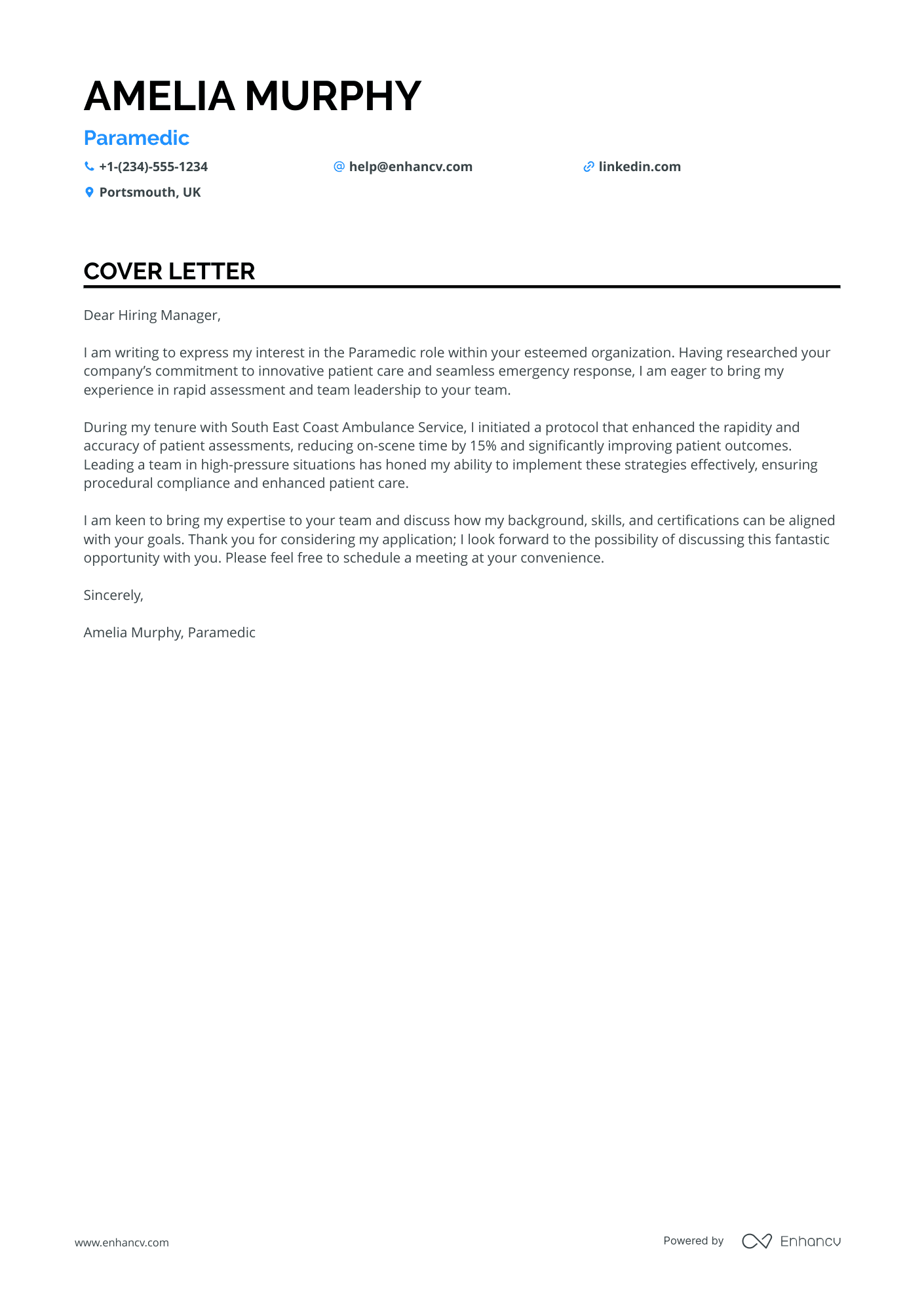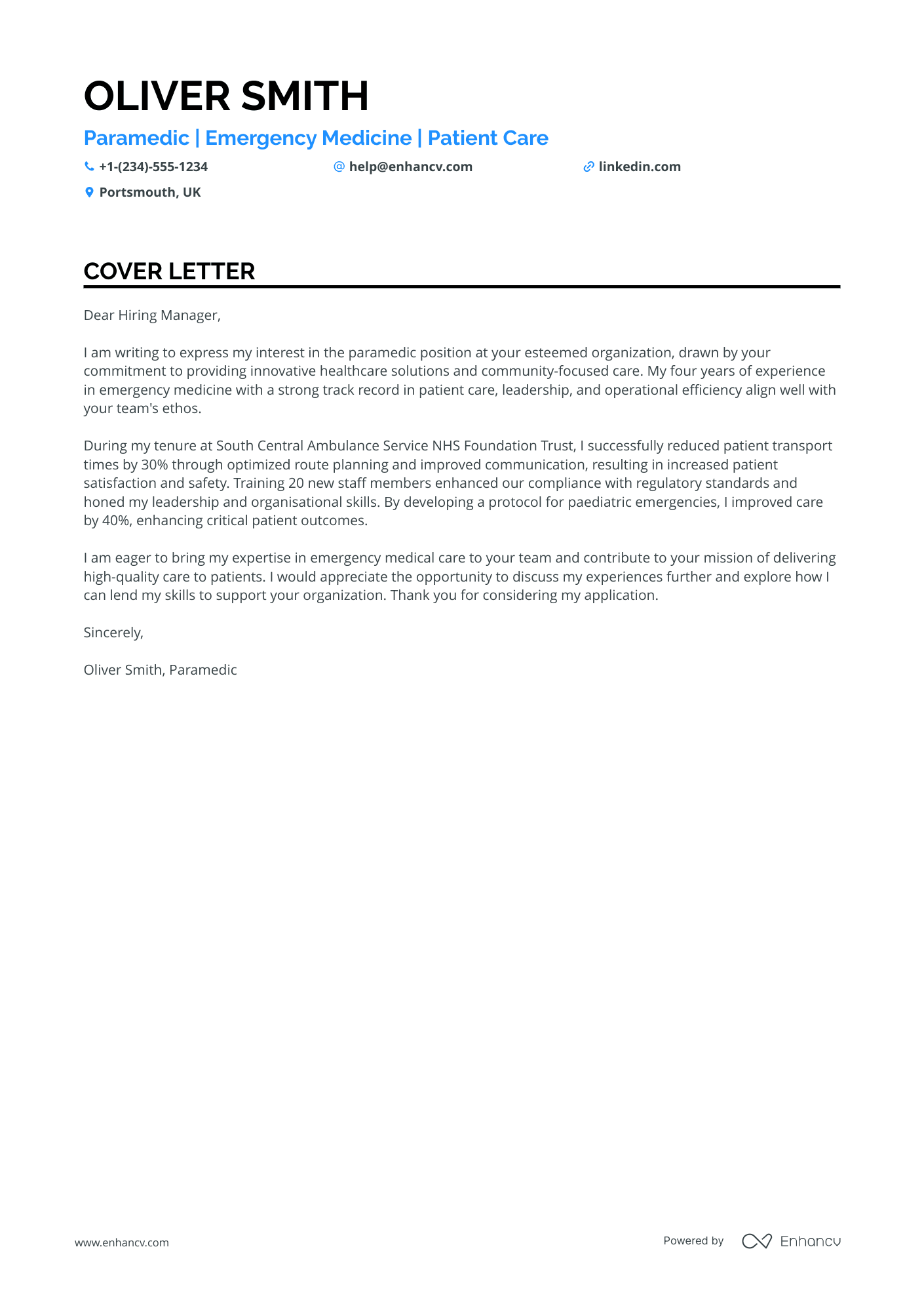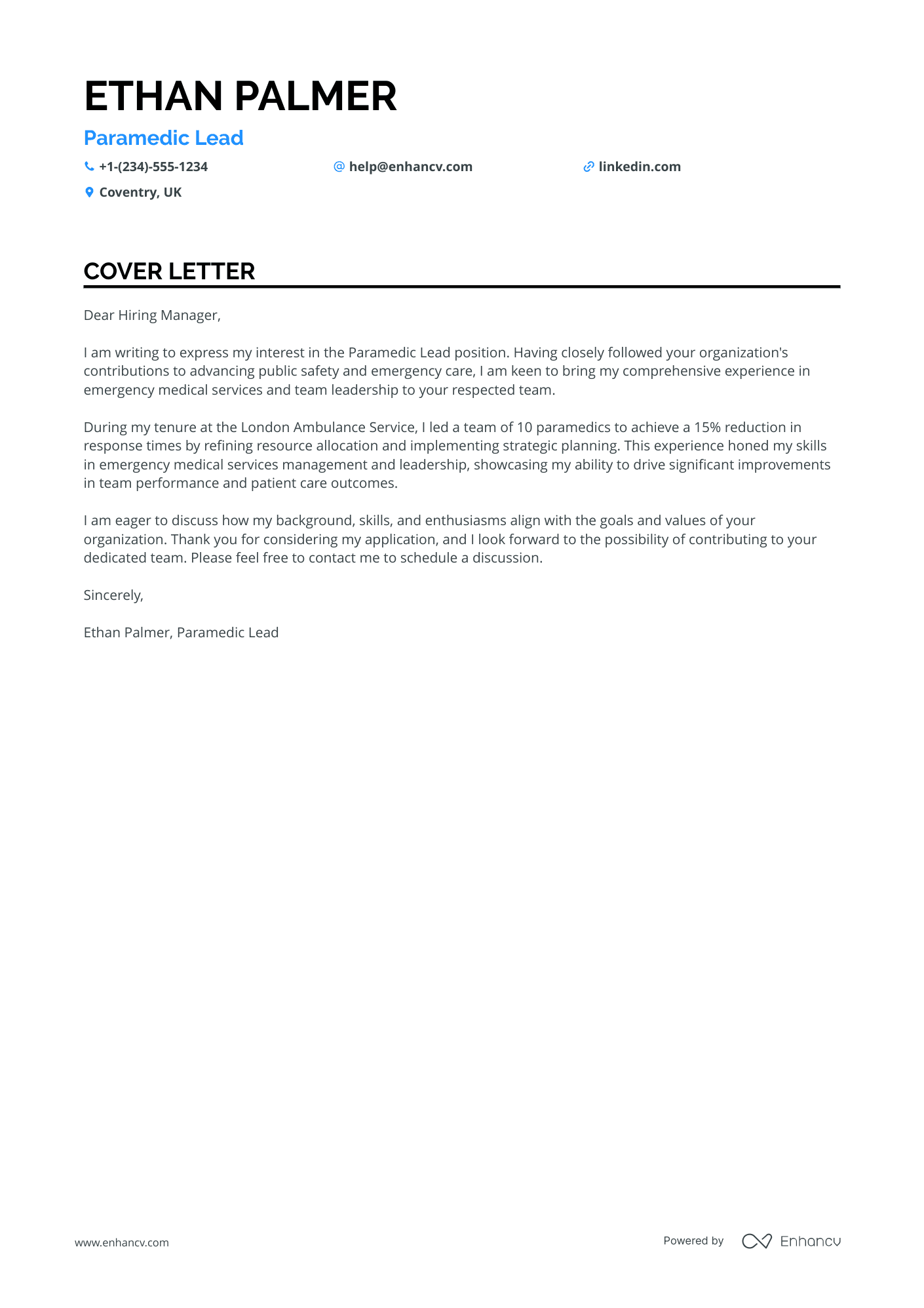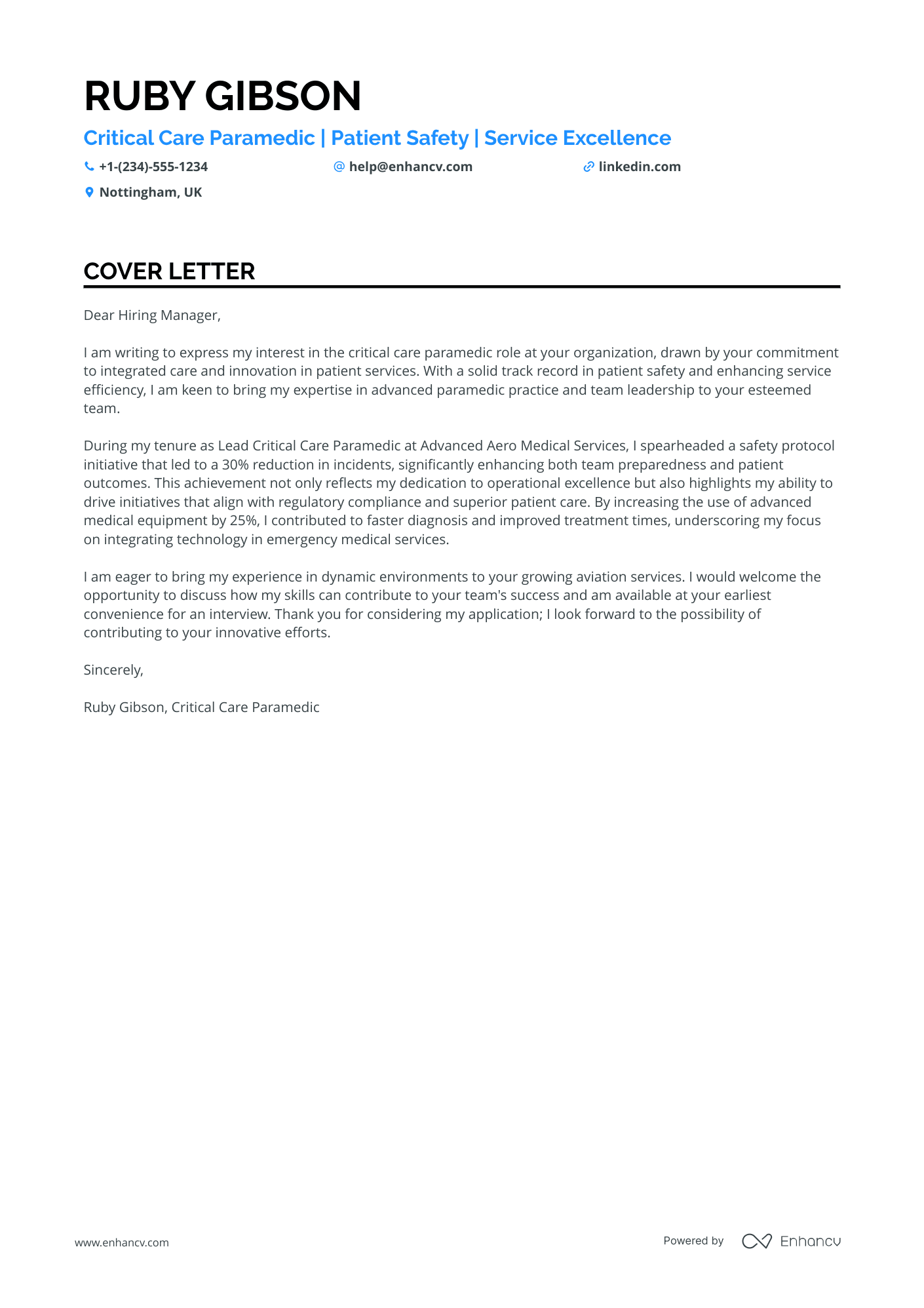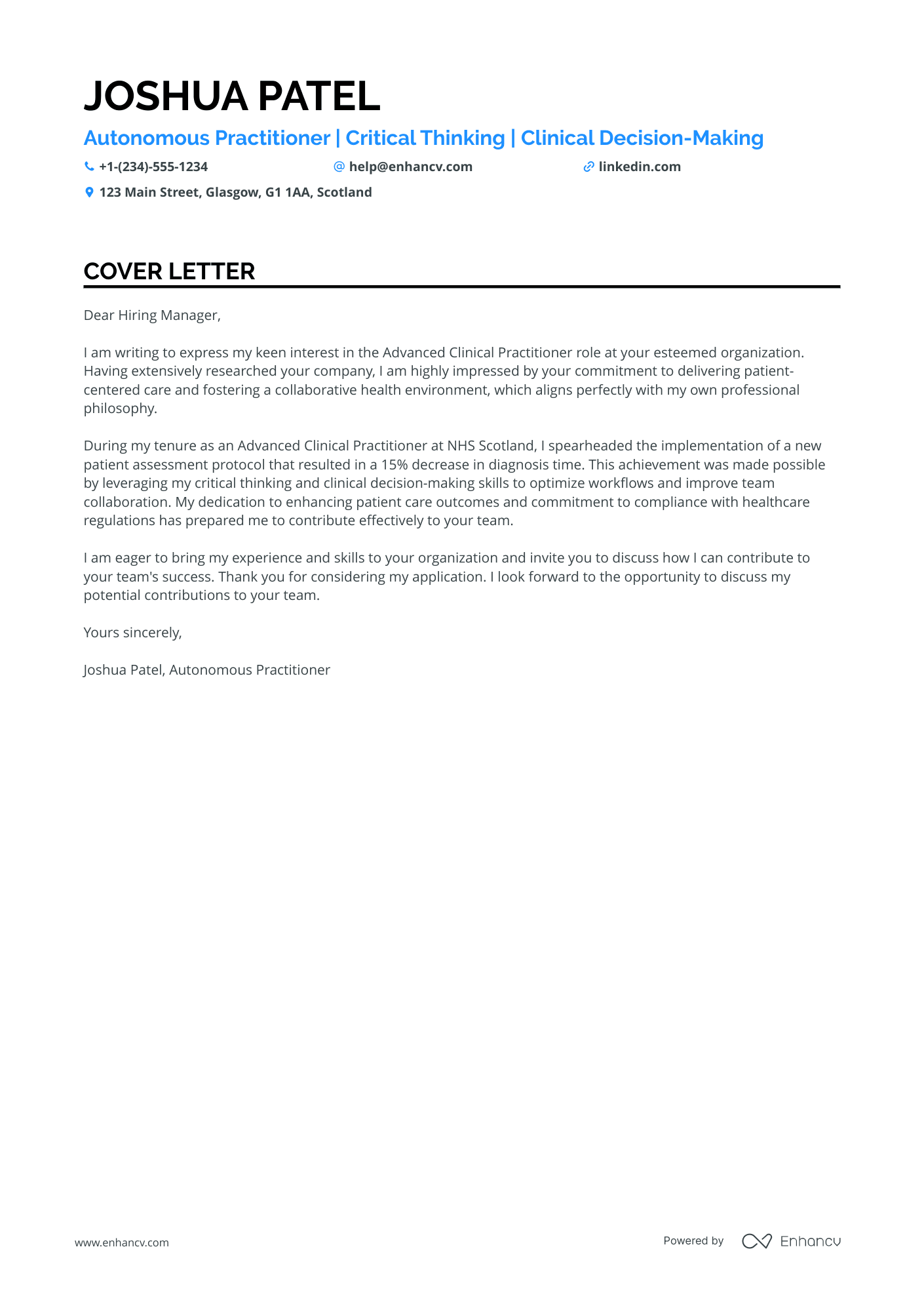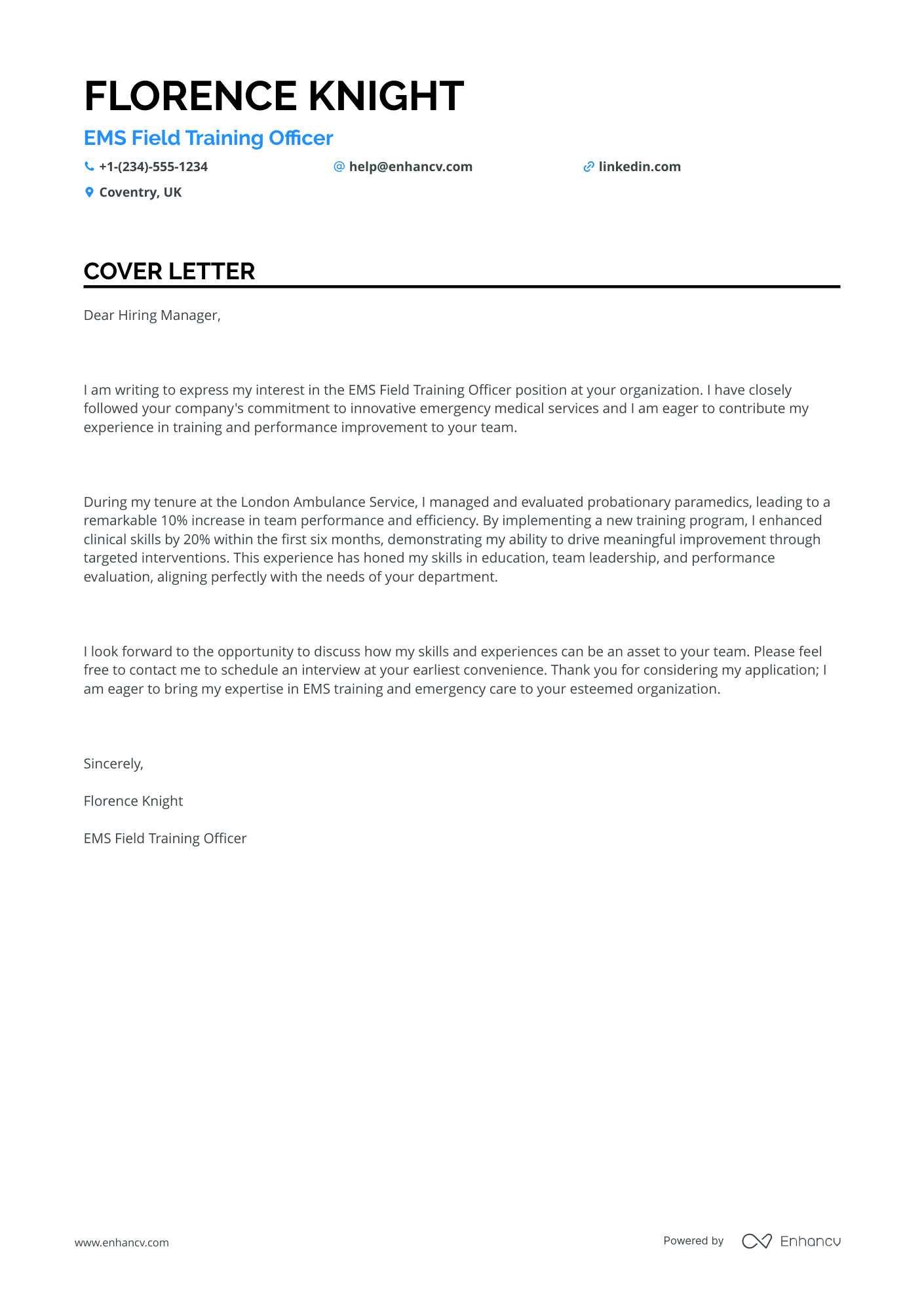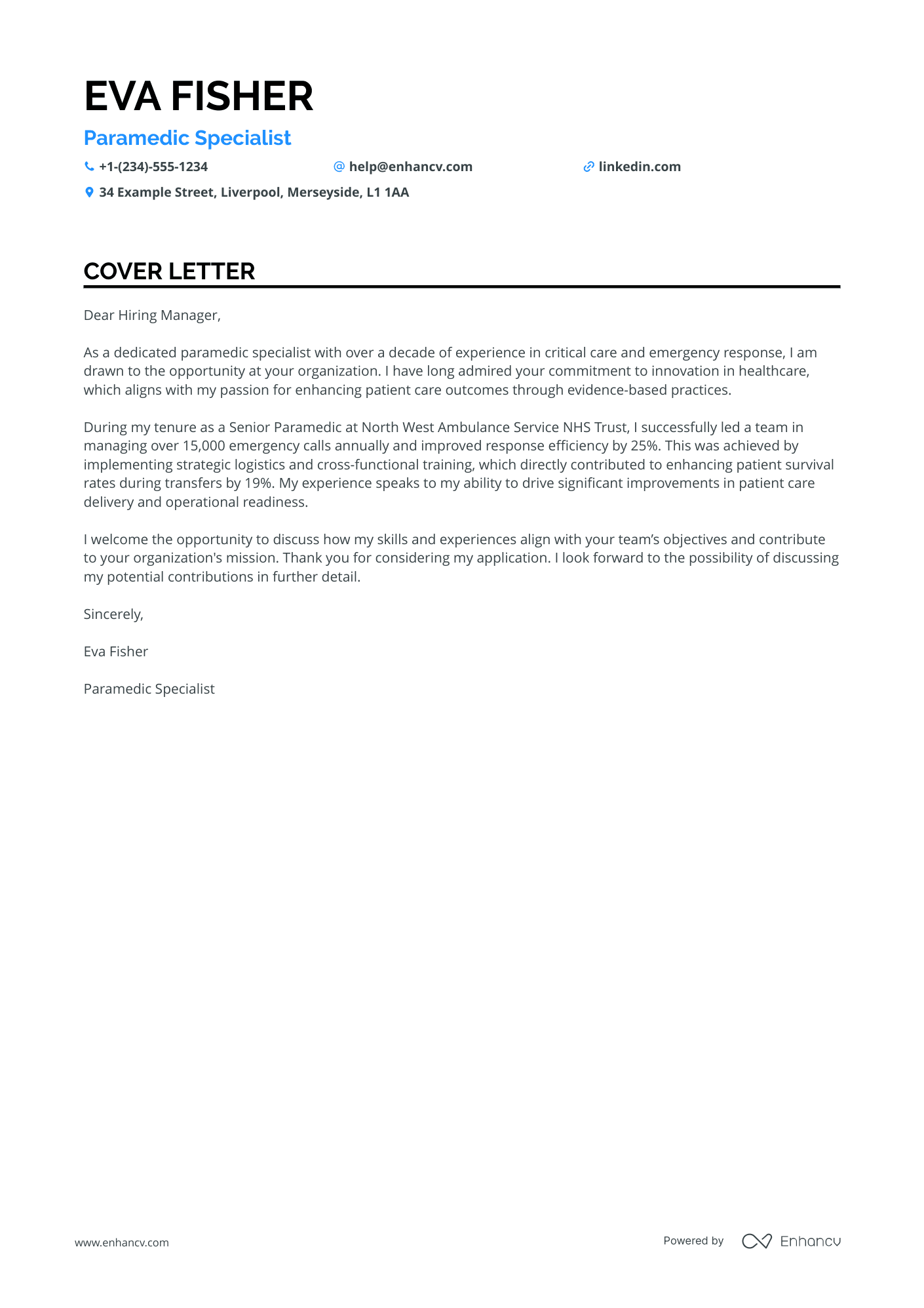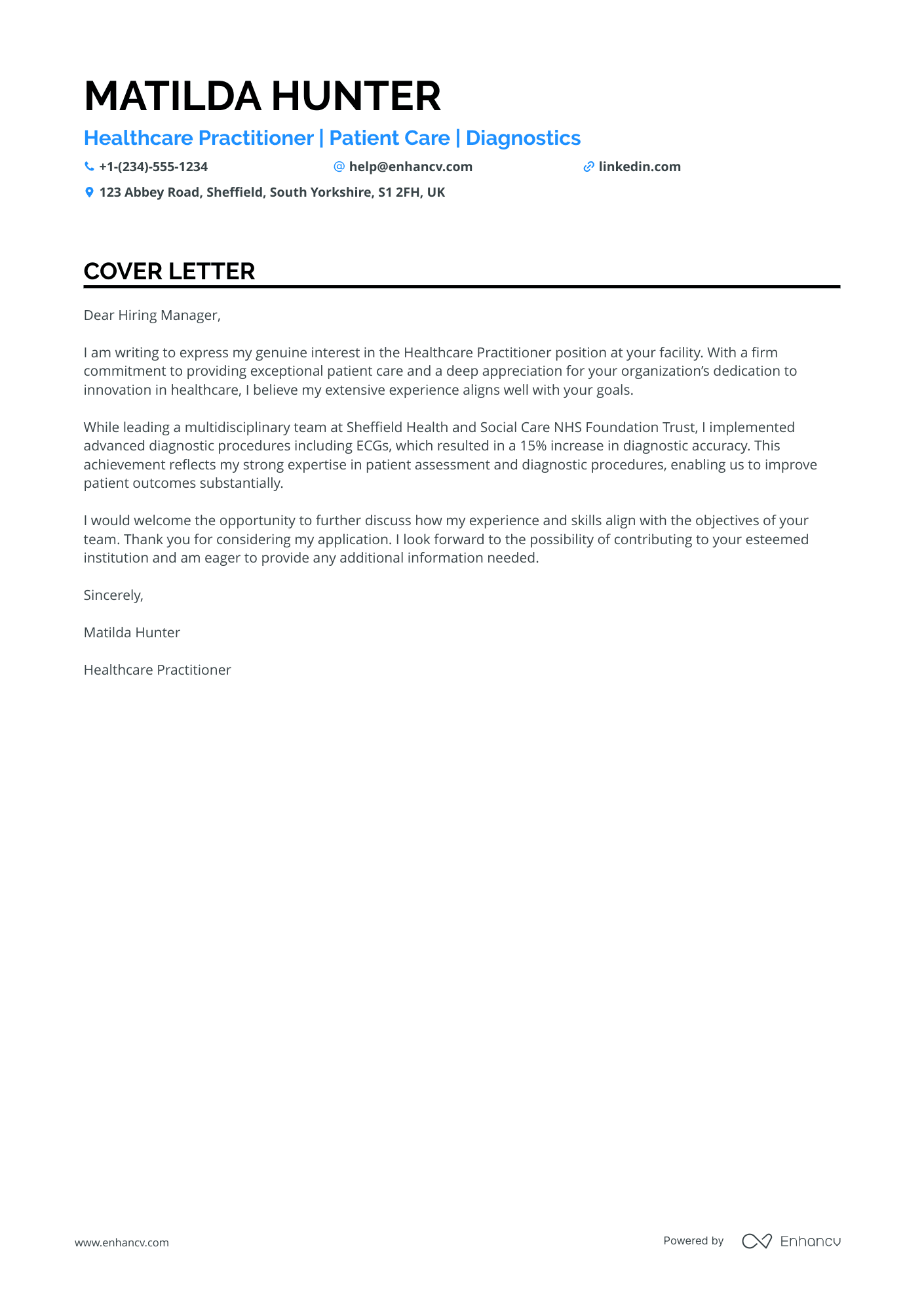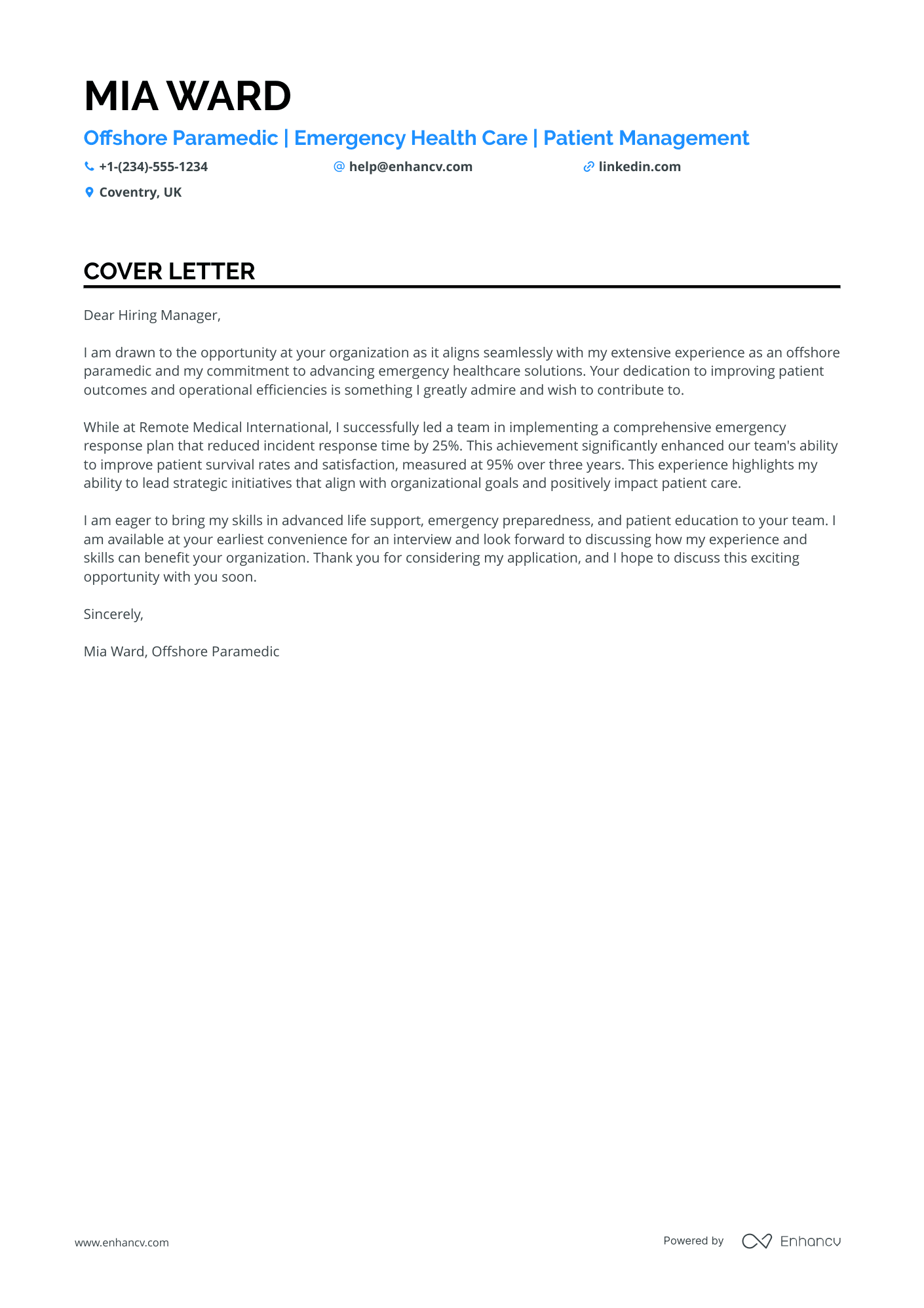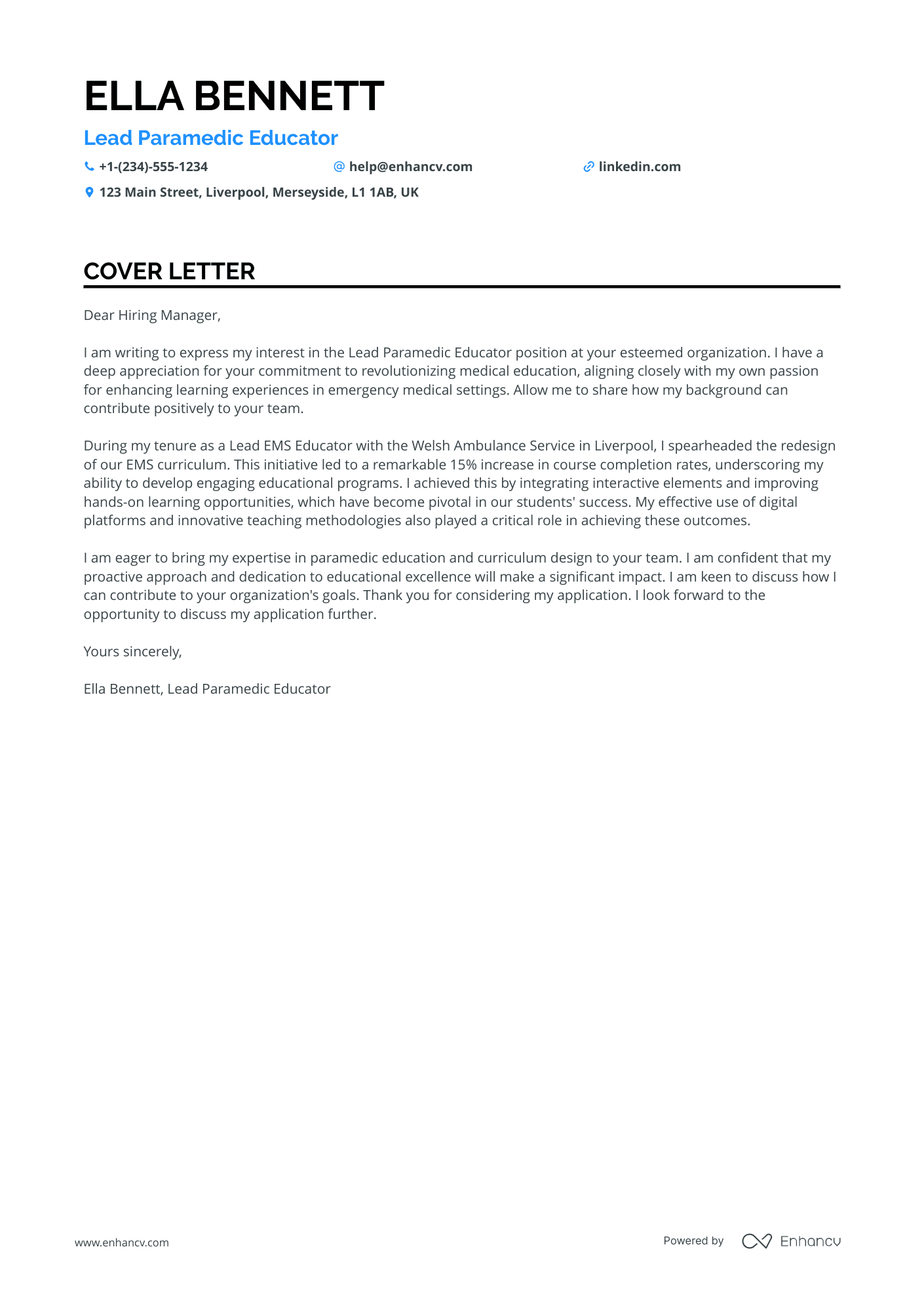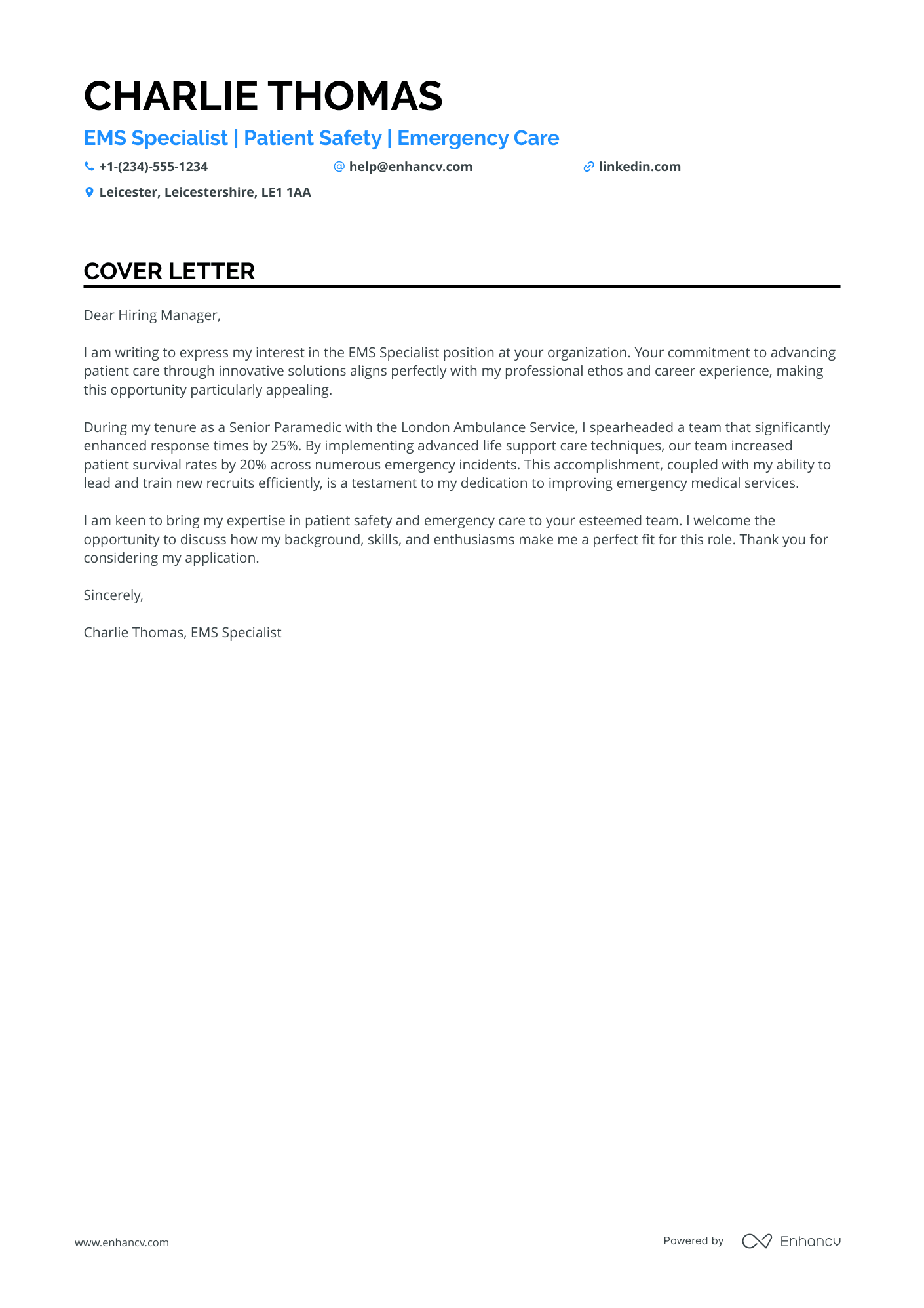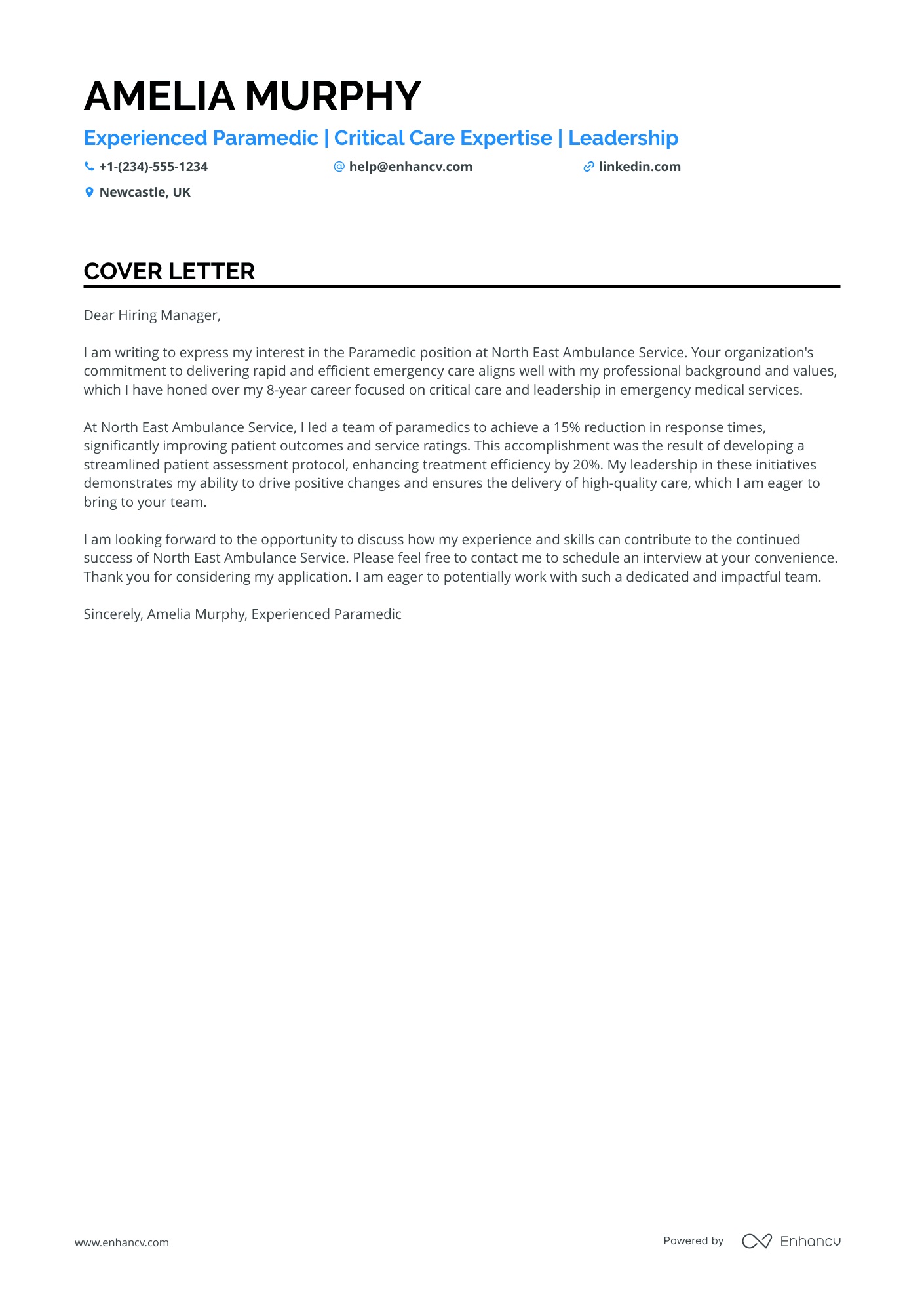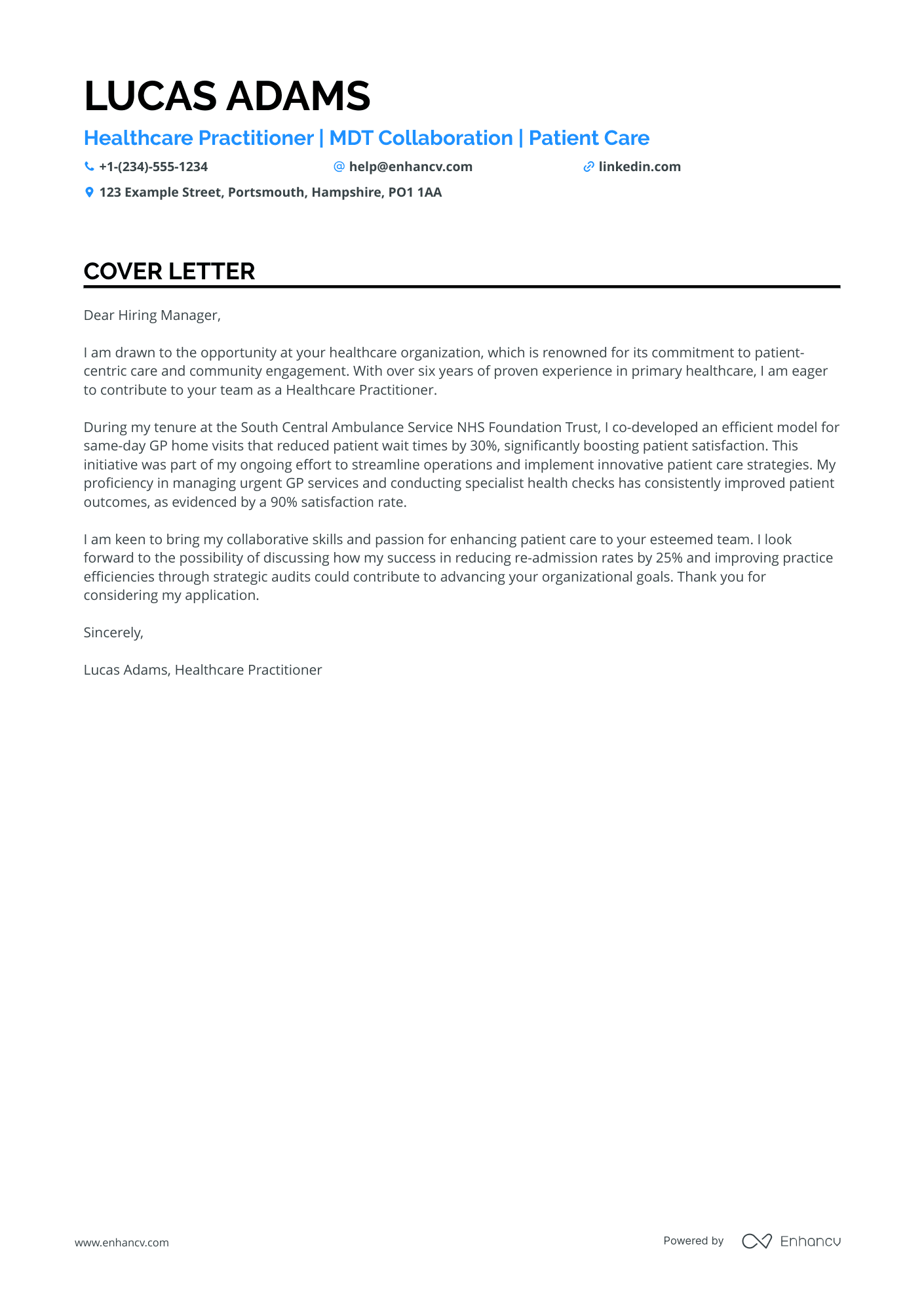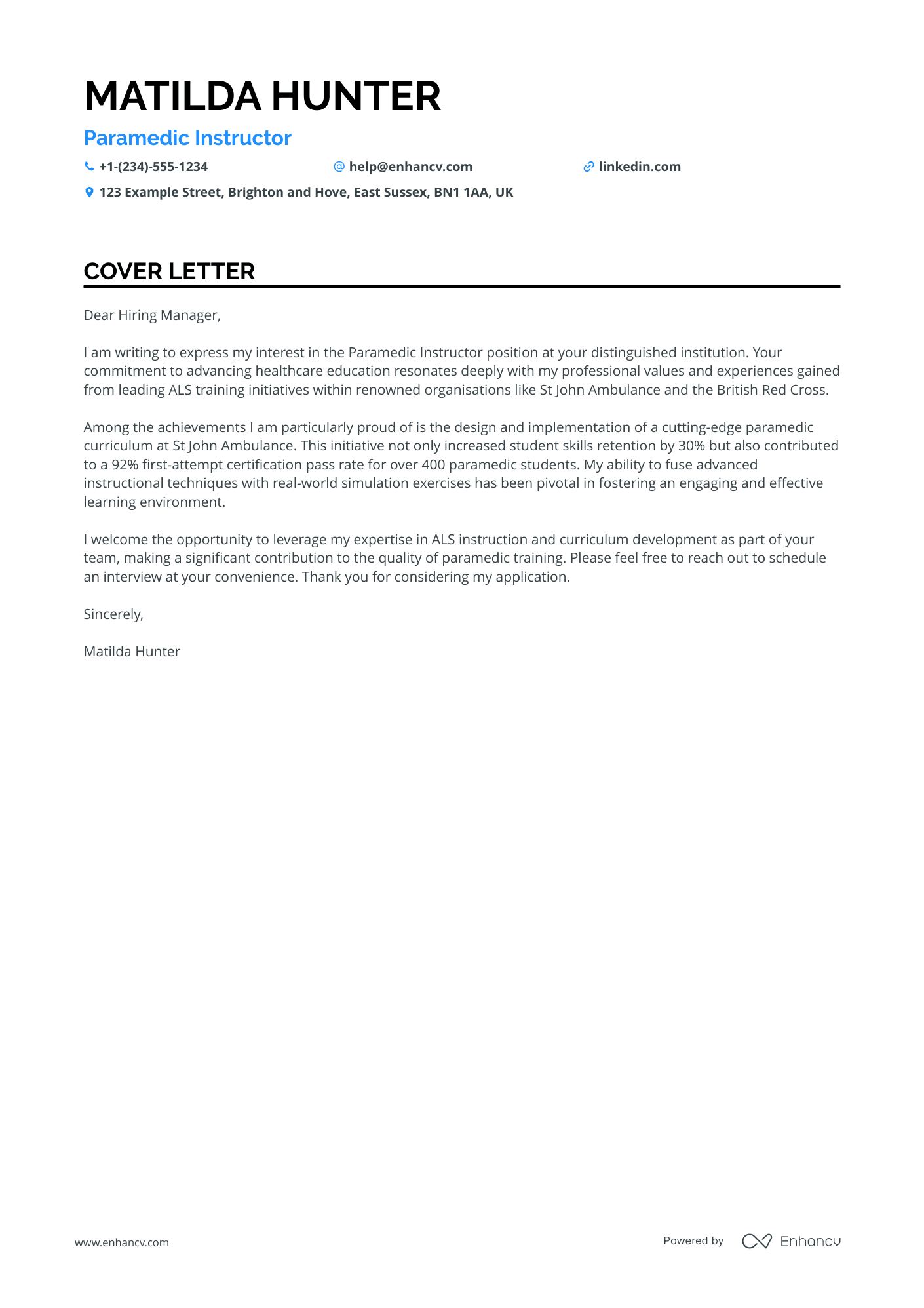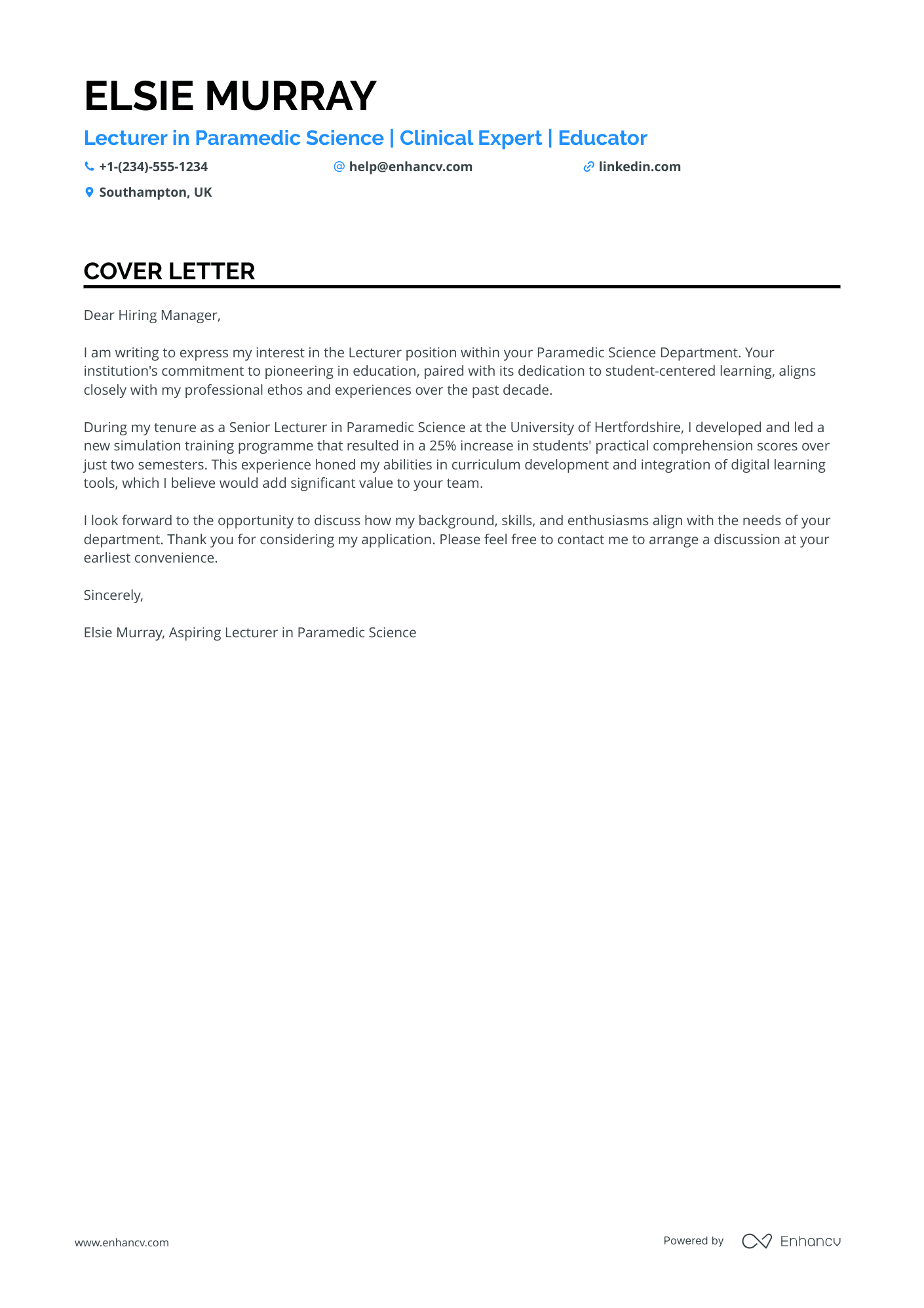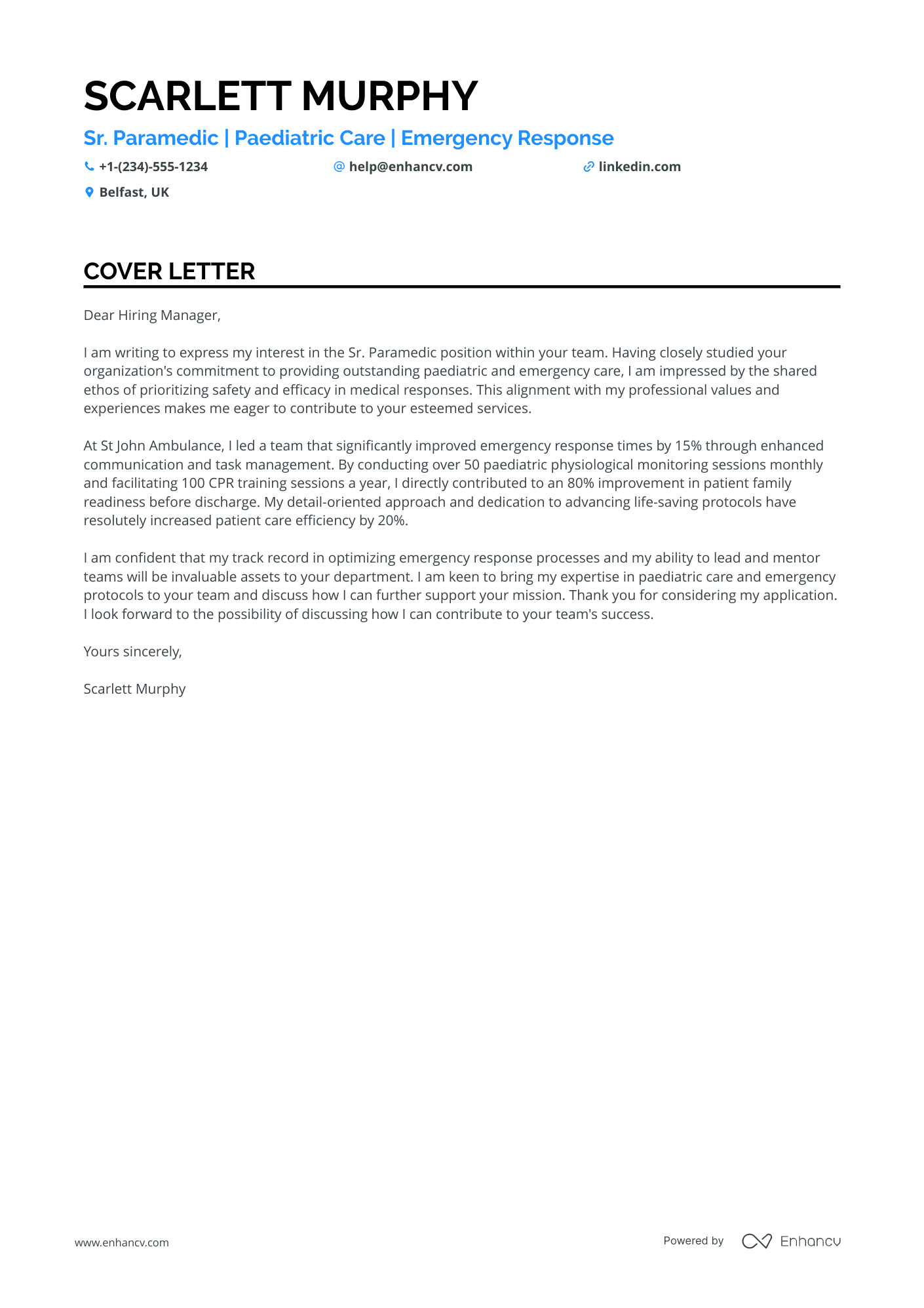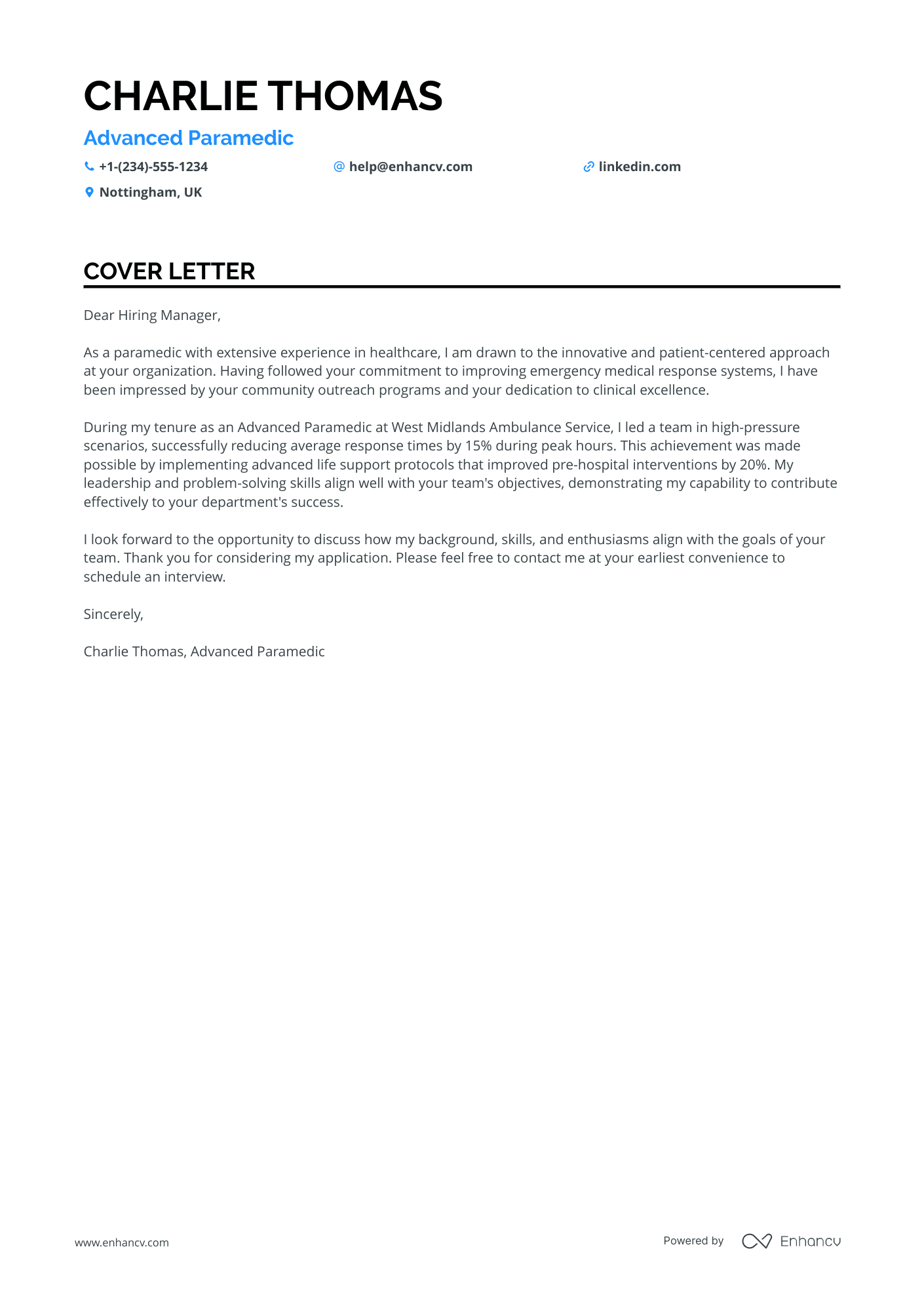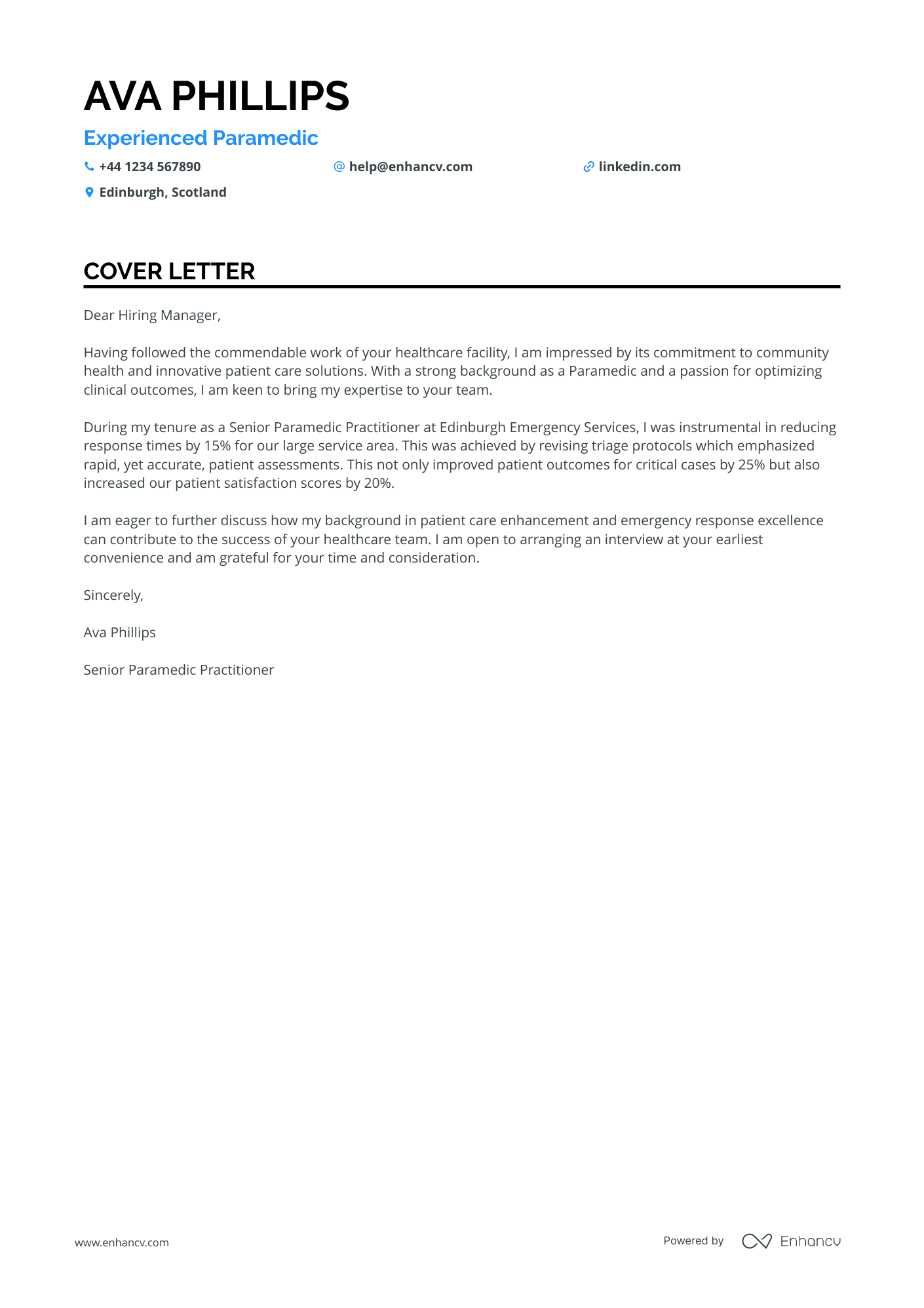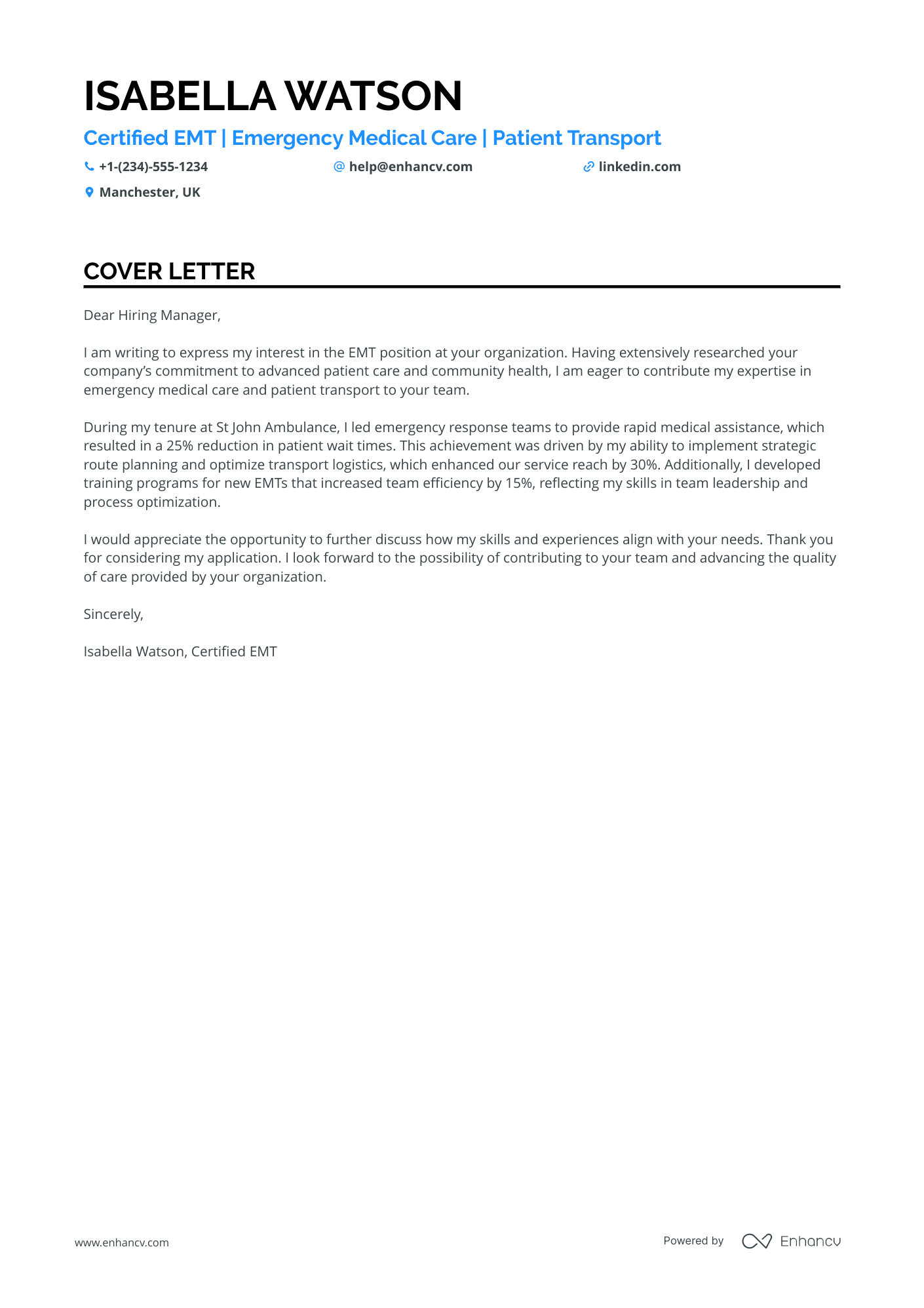You want your cover letter to strike the perfect balance between being professional and showing some personality. But how do you achieve this?
If you write too formally, your tone may come across as stiff. If you're too casual, it may sound overly conversational.
While modesty is always valued, how can you confidently present your skills without sounding arrogant or boastful?
This guide will help you find the right balance, ensuring your cover letter is both professional and personable, while focusing on the key job requirements.
Cover letter examples for paramedic
By Experience
Paramedic Supervisor
- Highlighting leadership and impact: The cover letter underscores the candidate's leadership qualities by detailing achievements such as leading a team to improve patient care quality by 25% and implementing protocols that reduced handover times by 12%, demonstrating tangible impacts in emergency care settings.
- Emphasising clinical supervision skills: References to coaching post-registration paramedics and conducting performance assessments illustrate competence in nurturing talent and driving professional development, aligning well with the supervisory role.
- Showcasing experience in emergency medical procedures: Mention of advanced life-saving certification and participation in over 100 emergency operations highlights the candidate's capability to manage high-pressure situations effectively.
- Addressing continuous professional development: By mentioning courses and a commitment to lifelong learning, the candidate shows a proactive approach to staying updated with the latest in emergency medicine, pertinent for a role that demands ongoing development and adaptation.
Senior Paramedic
- Highlighting the implementation of new triage procedures and innovative emergency response protocols showcases expertise in clinical leadership and capability in enhancing operational efficiency.
- Emphasising the role and successful outcomes in designing patient evaluation frameworks and leading healthcare delivery projects underlines the ability to drive improvements in patient care and satisfaction.
- Showcasing advanced training and mentorship programs reveals a strong commitment to team development and skill enhancement, crucial for leadership positions in healthcare.
- Listing relevant certifications such as the Advanced ILS Training Certification emphasises aptitude in life-saving techniques, aligning with the professional requirements of a senior paramedic role.
Paramedic Team Leader
- Highlighting Certifications: The cover letter effectively emphasises relevant certifications such as "Advanced Trauma Life Support" and "Paramedic Clinical Decision Making," which underscore specialised skills suitable for emergency medical roles.
- Emphasis on Achievements: By showcasing achievements like reducing response times by 20% and increasing ambulance service efficiency, the cover letter effectively demonstrates valuable contributions to previous employers and potential benefits to future employers.
- Communication and Community Engagement: The letter details efforts in organising community workshops and a youth engagement programme, highlighting an ability to engage and educate the public on emergency medical procedures, which is critical for a paramedic role.
- Leadership and Teamwork: Mentioning leadership roles, such as leading a team during high-pressure medical emergencies and collaborating with multidisciplinary teams, illustrates essential skills for managing the dynamic nature of paramedic responsibilities.
Paramedic Operations Manager
- Highlight specific achievements: Oliver's cover letter effectively showcases key accomplishments, like reducing patient transport times by 30%, proving his ability to implement efficient procedures.
- Emphasise leadership experience: Highlighting his role in supervising and training teams, such as improving team response time by 15% through initiating a training programme, underscores his leadership capabilities necessary for advancing in paramedic roles.
- Detail specialised skills: The mention of advanced clinical skills, including IV insertion and arrhythmia recognition, directly points to Oliver's capability to handle critical situations, an essential aspect for any emergency medical position.
- Focus on education and continuous learning: By mentioning his advanced degrees and specialised courses like Advanced Life Support, Oliver positions himself as a well-qualified candidate committed to ongoing professional development in emergency medicine.
Paramedic Clinical Lead
- Demonstrating Leadership in EMS: Highlighting experience in leading teams of paramedics and improving response times effectively showcases management ability, vital for a Paramedic Lead role.
- Certifications and Education: Emphasising advanced certifications like ACLS, PALS, and BLS, alongside a relevant MSc degree, signifies expertise and commitment to professional development, crucial in emergency care services.
- Proven Track Record in Protocol Implementation: Detailing past successes in protocol enhancements and training programs underlines the ability to drive improvements in emergency medical procedures, enhancing patient care and team performance.
- Language Skills: Mentioning proficiency in Spanish, in addition to native fluency in English, highlights communication skills beneficial for diverse patient communities and emergency scenarios.
By Role
Flight Paramedic
- Highlighting the candidate's experience in leading a team and improving emergency response efficiency, which showcases their leadership and organisational skills critical for the role of a Critical Care Paramedic.
- Featuring the proactive initiatives taken in developing safety protocols and managing regulatory compliance, demonstrating the candidate's commitment to patient safety and their ability to enhance operational standards.
- Emphasising the candidate's educational background and certifications, such as the Master of Science in Advanced Paramedic Practice and the Advanced Cardiovascular Life Support certificate, indicating a high level of expertise and commitment to professional development in critical care.
- Incorporating achievements related to patient satisfaction and team productivity improvements, which reinforce the candidate's effectiveness in delivering exceptional patient care and improving service efficiency.
Advanced Paramedic Practitioner
- Highlight certifications such as the "Advanced Primary Care Certification" from the Royal College of Nursing, emphasising expertise in advanced primary care practices, which is crucial for demonstrating specialised knowledge in autonomous practice.
- Emphasise achievements that illustrate the candidate's ability to improve patient outcomes and healthcare delivery, such as a 15% decrease in diagnosis time and a 20% increase in patient satisfaction, showcasing the candidate’s direct impact on service efficiency and patient care quality.
- Showcase the candidate’s leadership skills and team involvement, such as developing new assessment protocols and mentoring junior staff, to underline their ability to lead and support multidisciplinary healthcare teams effectively.
- Mention skills related to clinical decision-making, critical thinking, and advanced diagnostics as key competencies for a role that requires high-level autonomous practice and effective patient management.
Emergency Medical Technician Paramedic
- Highlight Relevant Certifications: Notable certifications such as the Advanced Life Support (ALS) and Trauma Life Support demonstrate specialised abilities crucial for emergency medical roles, enhancing the candidate’s credibility.
- Emphasise Key Achievements: By showcasing specific accomplishments like reducing emergency response times by 20% and leading logistical efficiencies, the candidate illustrates tangible impacts on improving operational effectiveness.
- Detail Experience in High-Stress Situations: Mentioning a 95% patient survival rate during emergencies underscores competence in handling crises efficiently, which is vital for an EMT role.
- Present Commitment to Education and Training: Developing and implementing training for new EMTs signals dedication to professional growth and improving team performance, which is attractive to potential employers.
Paramedic Field Training Officer
- Highlighting Specific Experience: Emphasise previous roles where you have managed teams or implemented training programs, as these demonstrate leadership capabilities essential for an EMS Field Training Officer.
- Quantifiable Achievements: Include specific improvements made to response times, team performance, or skill error rates, as these provide tangible evidence of your impact in previous positions.
- Emphasis on Training and Development: Focus on your experience in employee training, continuous education sessions, and the creation of personalised improvement plans, showcasing your ability to enhance team capabilities.
- Relevant Education and Certifications: Mention advanced qualifications or courses like a Masters in Emergency and Resuscitation Medicine or specialty training programs relevant to EMS, positioning you as well-prepared for the role's educational demands.
Critical Care Paramedic
- Highlight Certifications: The cover letter effectively highlights certifications like the Flight Paramedic Certification (FP-C) and International Trauma Life Support, which are crucial for establishing credibility and expertise in critical care paramedic roles that may involve specialised procedures or working in diverse and challenging environments.
- Showcase Leadership Experience: The letter outlines leadership roles, such as overseeing emergency operations, leading teams of paramedics, and implementing new care protocols. These experiences demonstrate the candidate's capability to manage high-stakes scenarios and optimise operational efficiency in emergency response situations.
- Emphasise Skills in Advanced Life Support: The document underscores skills in Advanced Life Support and patient stabilisation, critical for roles focused on emergency care and patient management, particularly in high-pressure environments requiring quick, informed decision-making.
- Detail Achievements in Operational Efficiency: By including quantifiable achievements such as reducing response times by 30% and increasing fleet operational readiness, the cover letter communicates the candidate's impact on improving emergency services' effectiveness and efficiency.
Community Paramedic
- Focus on Experience: The cover letter highlights over 7 years of experience in patient care and diagnostics, which is vital for demonstrating expertise and reliability in healthcare roles.
- Quantifiable Achievements: Including statistics such as a 25% improvement in patient satisfaction scores and a 30% reduction in unnecessary referrals demonstrates the candidate’s impact in previous roles.
- Specific Skills and Certifications: Mentioning skills like ECG interpretation and certification from the British Heart Foundation underscores the candidate's specialisation and commitment to continued professional development.
- Educational Background: Highlighting a Master of Science in Public Health and a Bachelor of Science in Nursing provides a strong educational foundation relevant to the healthcare sector.
Offshore Paramedic
- Highlight Relevant Experience: The cover letter effectively showcases over 5 years of ALS experience and specific roles in offshore, flight, and critical care, which emphasizes the applicant's breadth of knowledge and speciality in emergency medical scenarios suitable for the role.
- Specific Achievements: Including quantified achievements such as a 20% improvement in patient recovery rates and a 95% patient satisfaction rate clearly demonstrates the candidate's capability to deliver excellent patient care and achieve significant results.
- Relevant Certifications and Courses: The mention of Advanced Cardiovascular Life Support (ACLS) and International Trauma Life Support (ITLS) certifications aligns well with the specialised nature of the role, showing advanced competencies in lifesaving procedures.
- Demonstrating Skills and Competencies: Emphasising skills like Advanced Life Support, Infectious Disease Management, and Emergency Preparedness strengthens the application by aligning the candidate’s abilities with key job requirements.
Paramedic Educator
- Emphasising Leadership in Education: The cover letter effectively highlights the candidate's leadership roles and achievements in EMS education. This is crucial for a Lead Paramedic Educator position, demonstrating their capability to lead curriculum improvements and team efficiency.
- Quantifiable Achievements: The letter includes specific, quantifiable achievements such as a 30% improvement in student retention rates and a 15% rise in course completion rates. These numbers provide concrete evidence of the candidate's impact in their previous roles.
- Relevant Education and Continuous Learning: The candidate lists both a BSc in Paramedic Science and a Master of Education, underscoring a strong educational foundation for the teaching role. Additionally, relevant courses like ACLS and PALS indicate a commitment to continuous professional development in emergency medical education.
- Innovative Teaching and Technology Integration: By mentioning the revamping of teaching methodologies and the integration of Blackboard LMS updates, the candidate shows a forward-thinking approach and adaptability to new technologies, crucial in modern educational environments.
Special Operations Paramedic
- Highlighting Experience in Leadership Roles: Mention of spearheading and leading teams effectively illustrates the candidate's ability to take charge and improve operational efficiencies, which is crucial for senior positions in emergency medical services.
- Emphasising Achievements in Patient Safety and Response Times: The cover letter details specific improvements such as reducing response times and enhancing patient survival rates, underscoring the candidate's competency in enhancing patient outcomes.
- Showcasing Relevant Education and Continuous Learning: Featuring advanced degrees and ongoing training courses relevant to emergency medical services conveys a commitment to professional development, which adds value to the candidate’s profile.
- Demonstrating Technical Skills: Mentioning specific skills like ACLS and medical equipment management demonstrates proficiency in critical areas essential for an EMS Specialist, reinforcing the candidate’s capability in emergency care scenarios.
Ambulance Paramedic
- Emphasising experience in reducing response times and increasing patient satisfaction demonstrates measurable impact in emergency medical services.
- Highlighting leadership roles, such as leading a team or creating a mentorship programme, showcases the candidate's organisational impact and team development skills.
- Detailing specific certifications like Advanced Trauma Life Support underscores specialised skills relevant to critical care and trauma management.
- Mentioning successful technology integration projects and their outcomes showcases adaptability and a forward-thinking approach in emergency medical systems.
Remote Paramedic
- Emphasise expertise in MDT collaboration and patient care, highlighting a strong track record of enhancing patient outcomes and satisfaction rates, which is critical for roles in healthcare settings.
- Highlight specific achievements such as the development of a model for same-day GP home visits and a collaborative project for ECG interpretation, demonstrating innovation and practical impact on service delivery.
- Showcase relevant educational background, including an MSc in Advanced Clinical Practice, reinforcing credentials and depth of knowledge in the field.
- Include specialised courses like Advanced ECG Interpretation to underscore advanced skills in diagnostic aspects, which are crucial in a paramedicine role.
Paramedic Instructor
- Highlight relevant certifications: The cover letter effectively emphasises specific courses such as the Advanced Cardiac Life Support (ACLS) Instructor Course, which aligns with the role's focus on ALS training.
- Detail impactful achievements: The letter showcases measurable outcomes like a 92% first-attempt certification pass rate, providing concrete evidence of educational effectiveness.
- Emphasise leadership experience: The letter outlines leadership roles in managing and mentoring teams, such as coordinating professional development workshops, relevant for a Paramedic Instructor position.
- Showcase passion and commitment: The cover letter includes passions related to innovating paramedic training techniques, demonstrating a genuine commitment to advancing within the field.
Paramedic Science Lecturer
- Demonstrating Specialised Expertise: Elsie effectively highlights her specialised expertise in simulation-based learning, beneficial for a Lecturer in Paramedic Science, by showcasing enhancements in both practical comprehension and student engagement.
- Emphasising Teaching Achievements: The cover letter succinctly details Elsie's contributions to student satisfaction and learning outcomes, particularly the improvement in comprehension scores and reduced dropout rates, which underscore her teaching efficacy.
- Highlighting Leadership and Collaborative Initiatives: Elsie's engagement in inter-departmental collaboration and successful maintenance of accreditation demonstrates her capability to lead and work collaboratively, crucial for educational leadership roles.
- Showcasing Research and Publication Record: By mentioning peer-reviewed publications and contributions to emergency response efficiency, Elsie aligns her scholarly work with practical improvements, adding significant value to her academic role.
Industrial Paramedic
- Highlight Relevant Experience: Emphasise the applicant's extensive experience in paediatric and emergency care, demonstrating their ability to efficiently manage critical situations, evidenced by a 20% improvement in patient care efficiency.
- Specific Certifications and Education: Mention certifications and education that are relevant to the role, like the "Paediatric Advanced Life Support" and "Advanced Cardiac Life Support" certifications, as well as advanced degrees in paramedic and clinical practice.
- Achievements with Quantifiable Impact: Include specific achievements with measurable outcomes, such as improving response times by 15% and reducing emergency room bottlenecks by 25%, to convey competence and capability effectively.
- Leadership and Training Focus: Detail leadership roles and training initiatives, like leading CPR training sessions and training new recruits, to highlight the ability to enhance team readiness and community engagement.
Tactical Paramedic
- Highlighting the "Advanced Cardiac Life Support" and "Pre-Hospital Trauma Life Support" certifications emphasises the candidate's specialised skills in handling critical and traumatic medical emergencies.
- Emphasising the ability to improve response times and patient outcomes showcases the candidate’s effectiveness and potential for operational enhancement in emergency medical services.
- Mentioning leadership roles and mentorship achievements reinforces the candidate’s capacity to lead and develop teams, crucial for roles requiring team management and training.
- Underscoring community engagement activities and awards conveys a commitment to public health and safety, aligning with organisational goals to improve community readiness and involvement.
Paramedic cover letter example
Ava Phillips
Edinburgh, Scotland
+44 1234 567890
help@enhancv.com
- Highlight specific achievements that demonstrate your impact on patient care, such as reduced response times and improved patient outcomes, to showcase effectiveness and dedication.
- Include relevant positions and roles, such as "Senior Paramedic Practitioner," to emphasize leadership experience and specialized capabilities in emergency services.
- Show familiarity with the prospective employer's dedication to community health and patient care solutions, which reflects a genuine interest and alignment with their values.
- Express openness for further discussion, indicating availability for interviews and appreciation for the hiring manager's time, demonstrating professionalism and eagerness.
Importance of cover letters in the United Kingdom
Cover letters are a crucial tool in making your application personal and engaging.
Here are three reasons why they matter:
- Personalisation: Unlike a CV, a cover letter allows you to show your enthusiasm for the role, giving a more personal insight.
- Addresses details about your career: Whether you’re changing careers or have gaps in employment, your cover letter offers a space to explain these in a constructive way.
- Meeting the job requirements: Your cover letter should be unique and tailored, clearly showing how your skills align with the role requirements.
What UK employers expect from a cover letter
Your UK employers will appreciate your application if you've taken the effort to tailor your cover letter to their job requirements.
Here’s how to ensure yours ticks all the right boxes:
- Research the company thoroughly: It's not enough to have only read the job advert. Look into the company's history, products, services, and recent achievements to demonstrate your genuine interest and knowledge.
- Connect with the company’s values: Every company has core principles that shape its culture and operations. Identify these values and use your cover letter to show how they align with your professional conduct and ethics.
- Emphasise your relevant skills: Highlight specific skills that match the job description and are most in demand. Use examples from your previous experience to support your claims and set yourself apart from other candidates.
How to format a paramedic cover letter
Before diving into the content, the structure of your cover letter should include the following elements:
- Your address and contact details
- The employer’s name and address
- Date
- Salutation or greeting
- Opening or introductory paragraph
- Middle or body paragraphs
- Closing paragraph
- Sign-off and signature
When it comes to the best font choice, consider modern options like Lato, Rubik, Raleway, Volkhov, Chivo, or Bitter as alternatives to Arial or Times New Roman.
Your cover letter should be single-spaced, with approximately 1-inch (2.5 cm) margins all around (our templates are set up automatically with this spacing in mind).
Ensure your CV and cover letter use the same font for consistency, and always send them as a PDF to prevent edits and maintian formatting.
Lastly, while Applicant Tracking Systems (ATS—the software used to match your application to set requirements) won't read your cover letter, recruiters certainly will, so make sure it stands out.
How to write your paramedic cover letter salutation
It's never advisable to begin your cover letter with 'Dear Sir/Madam', as it sounds comes across as impersonal.
Take the time to find out who is hiring for the role and address them directly in your cover letter greeting (e.g., 'Dear Mrs Chanceworth', 'Dear Harrod').
If you're uncertain where to find the hiring manager’s name, check the company website, look on LinkedIn, or send a courteous email requesting this information. Don't hesitate to ring reception either—they are unlikely to refuse to assist.
How to write your paramedic cover letter intro
While your cover letter should remain professional, adding a touch of personality or humour can make you stand out.
Hiring managers sift through countless applications, day in and day out. Anything unique or personable that grabs their attention could give you a competitive edge.
But do your homework first to ensure a dash of creativity would be appropriate and suitable to the company culture.
How to write your paramedic cover letter body
A well-written cover letter body goes beyond the content of your CV, expanding on your greatest achievement to form your compelling case.
The narrative you tell within it could focus on a few key elements:
- A concrete and noteworthy achievement: Backed by data and relevant to the job.
- Your hard and soft skills: Presented with measurable outcomes and results.
- A successful project: Showing how you contributed to the final result.
The goal is to tell a story that aligns with the company’s needs and adds a more human touch to your application.
How to write a closing paragraph
Looking to leave a lasting impression with your cover letter closing?
Then, you should certainly end with a promise—one that outlines what you aim to achieve in the role. Ensure your goals are realistic and align with the company’s needs.
You might also include a call to action, enquiring when you can expect to hear back and what the next steps in the hiring process will be.
Conclusion
Your cover letter is an opportunity to showcase your personality and skills to potential employers. Start by addressing the hiring manager by name and tailoring your content to reflect the role’s requirements.
Include a specific example of your greatest achievement to illustrate your suitability for the position, while also expressing your enthusiasm for the company. Remember to format your letter professionally, ensuring it aligns seamlessly with your CV.
